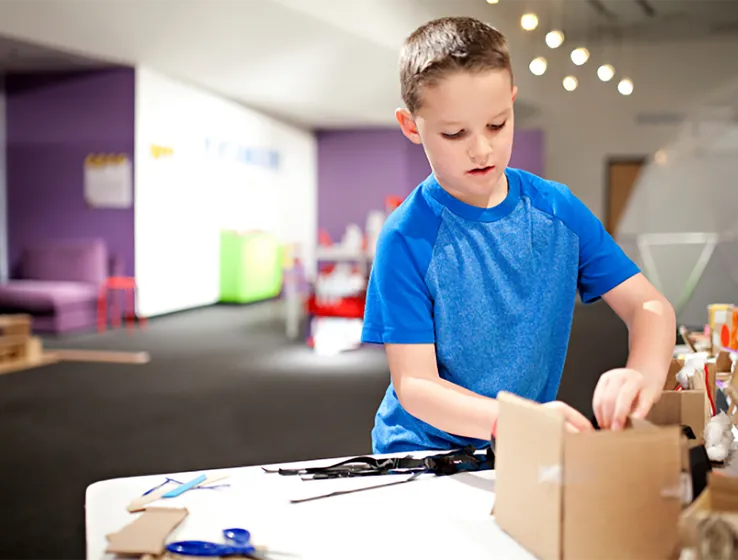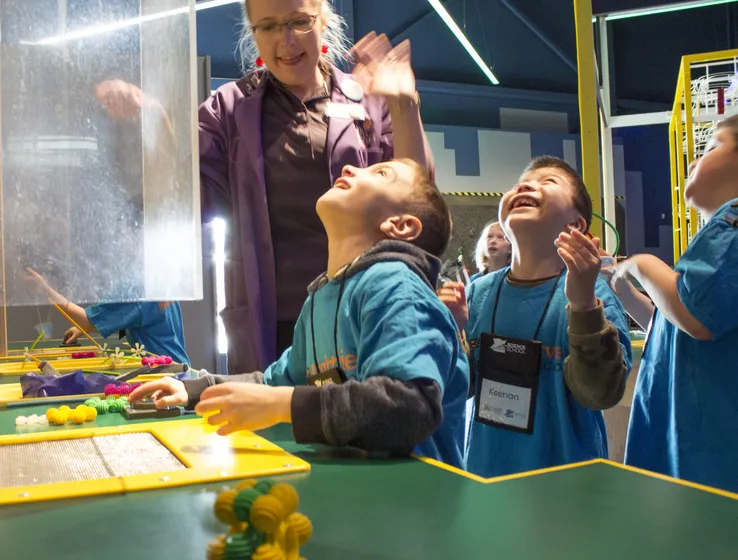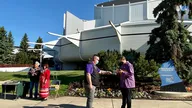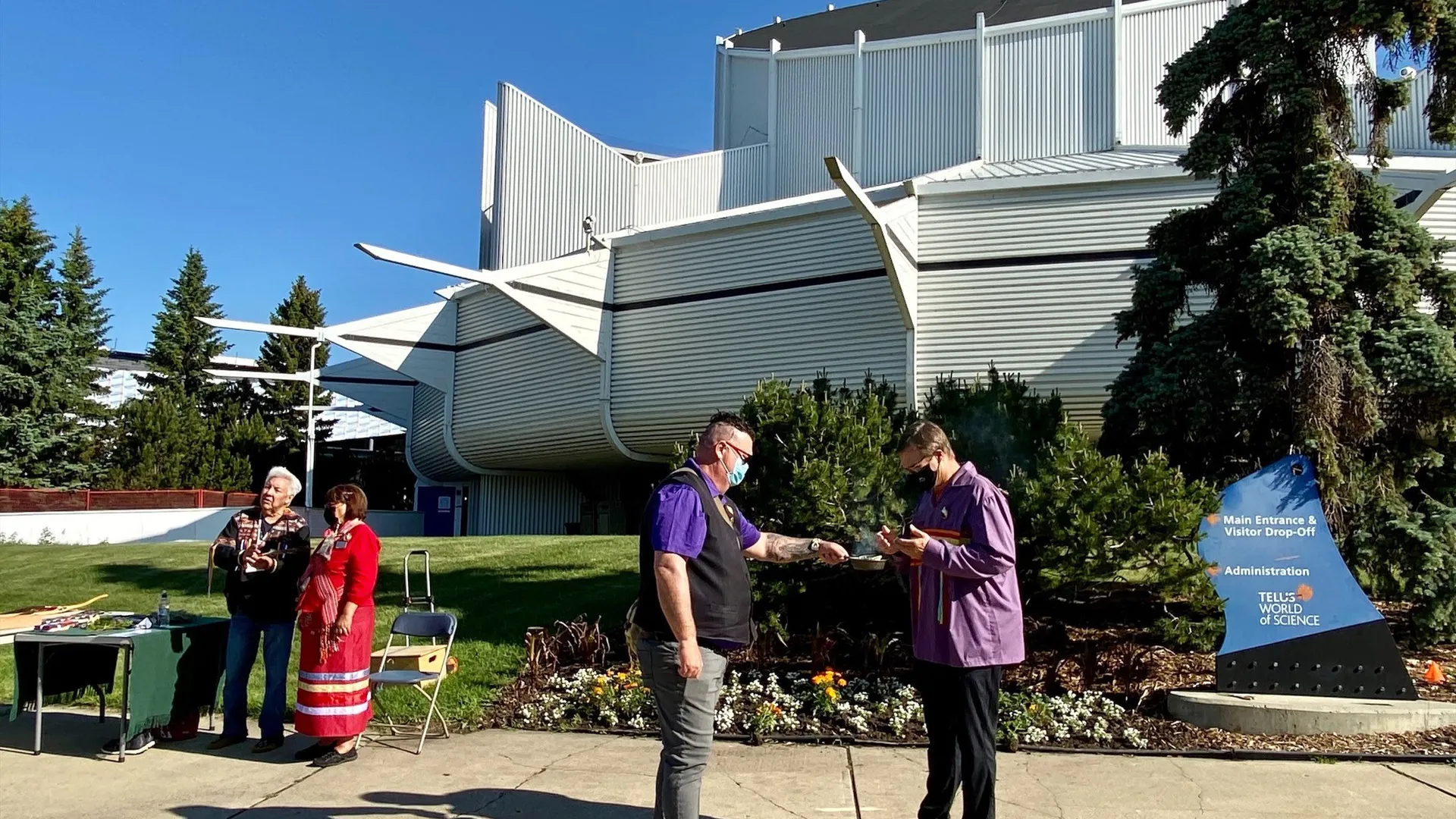National Indigenous History Month: Smudging
Posted:
For National Indigenous History Month, we will be sharing a few blogs about Indigenous culture. We encourage you to take the time to learn about Indigenous history and current events. In this blog, Lynn Lush teaches us about smudging.
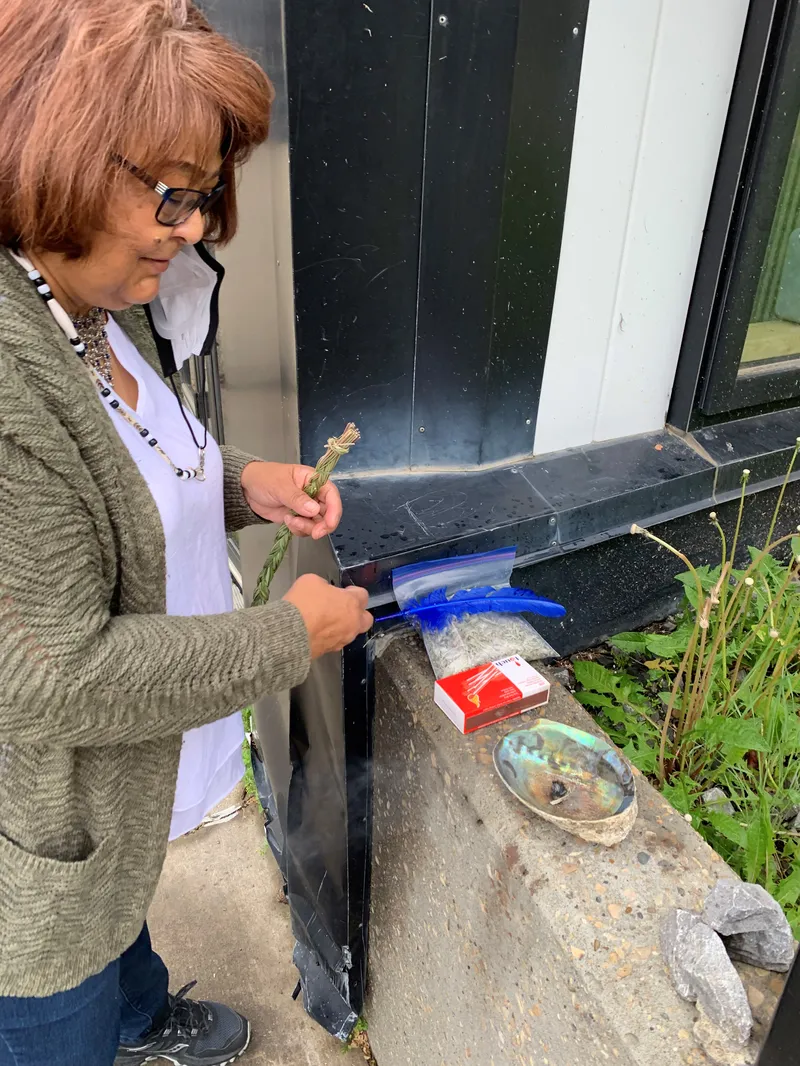
Lynn Lush showing us how to smudge.
Meet Lynn Lush, she’s the Indigenous Land Based Learning Navigator at TELUS World of Science – Edmonton and the author of this blog.
Lynn Lush (whose Indigenous name is Blue Thunderbird woman - ozhaawashko binesi ikwe) is originally from Manitoba. Lynn grew up in British Columbia with her adopted family. She is a survivor of the residential school system and the Sixties Scoop. At age 13, she started a journey to reclaim her traditional knowledge. She was taught by Elder Albert Lighting in Alberta, and several Elders from Manitoba, Nova Scotia, and British Columbia.
Lynn has lived in Edmonton for 10 years and is very active with Indigenous organizations. She enjoys teaching and sharing her knowledge with students and others curious about Indigenous culture. Lynn is an accomplished craftsperson and teaches how to make fish scale art, dreamcatchers, medicine pouches, ribbon skirts. She also holds traditional knowledge in healing medicines.
In this blog, Lynn will discuss the significant role of smudging in Indigenous culture.
What is smudging?
Smudging is a cultural ceremony practiced by a wide variety of Indigenous people in Canada and other parts of the world. Smudging is the practice of burning various medicinal plants to cleanse ourselves and connect us with our spirit and with the Creator.
It may also be used to cleanse, purify, and bless the part of our mother earth. For example, we may smudge around the sweat lodge or powwow and our homes to purify or bless special objects like ceremonial objects or totems, such as jewelry, rattles, or clothing. When you smudge your home, start from the left side of the walls, windows, doorways, and corners of the room and open the window and door to let negative energies out.
Of the four sacred medicines* given to us by the Creator, sage* is most often used in most smudging ceremonies. However, traditional teachers and knowledge keepers from various Indigenous Nations will have more specific teachings that go with each medicine. Non-Indigenous people should consult with these Indigenous experts about how to properly acquire, use, give, or ceremonially include the medicines in any cultural practice.
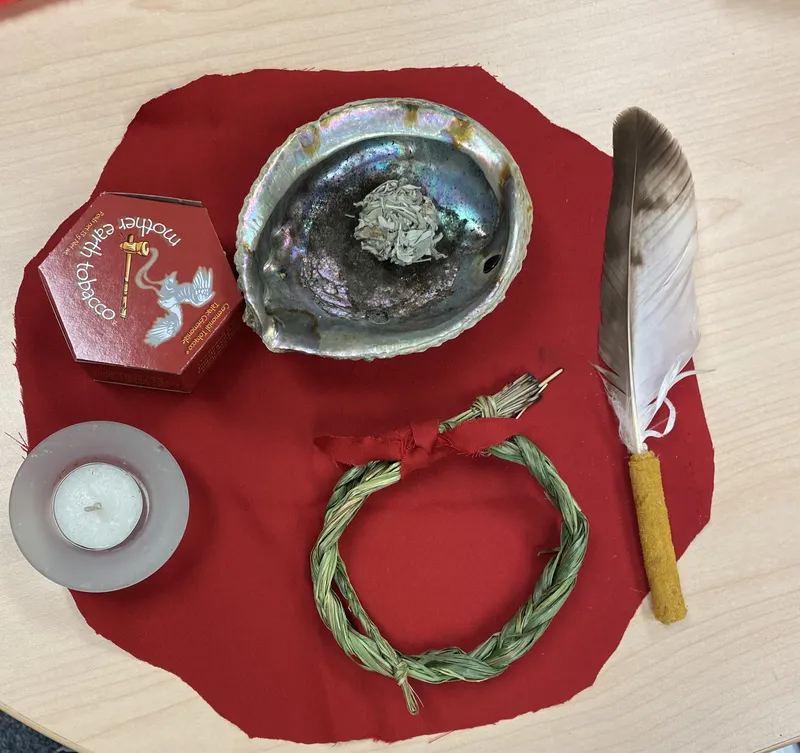
Items used for smudging.
The smudging ceremony
Our Elders teach us that all smudging ceremonies must be entered into or begun with good intent. During the ceremony, the smoke rises, and prayers rise to the Spirit world of our grandfathers, grandmothers, and the Creator.
The smudging ceremony helps participants centre or ground themselves. Negative energy, feelings, and emotions are lifted away and used for healing of mind, body, and spirit, as well as balancing energies. Smudging also unifies the energies and the people within the circle. When we smudge, we normally inform participants to remove any metals such as watches, jewelry, and eyeglasses because it is believed that metals hold too much negative energy.
You must also be cautious to not add anything to the smudge to contaminate it. This includes how we smudge with the smoke. For example, once the sage is lit, we use an eagle feather or plume to disperse the smoke. We never directly blow on the medicine because it risks transferring any negative energy.
My Elders have often said that no one should ever be forced or pressured to smudge during a ceremony. If anyone does not know how to smudge or if they feel reluctant, they can step back and watch or say, “all my relations” to indicate they’d like to pass.
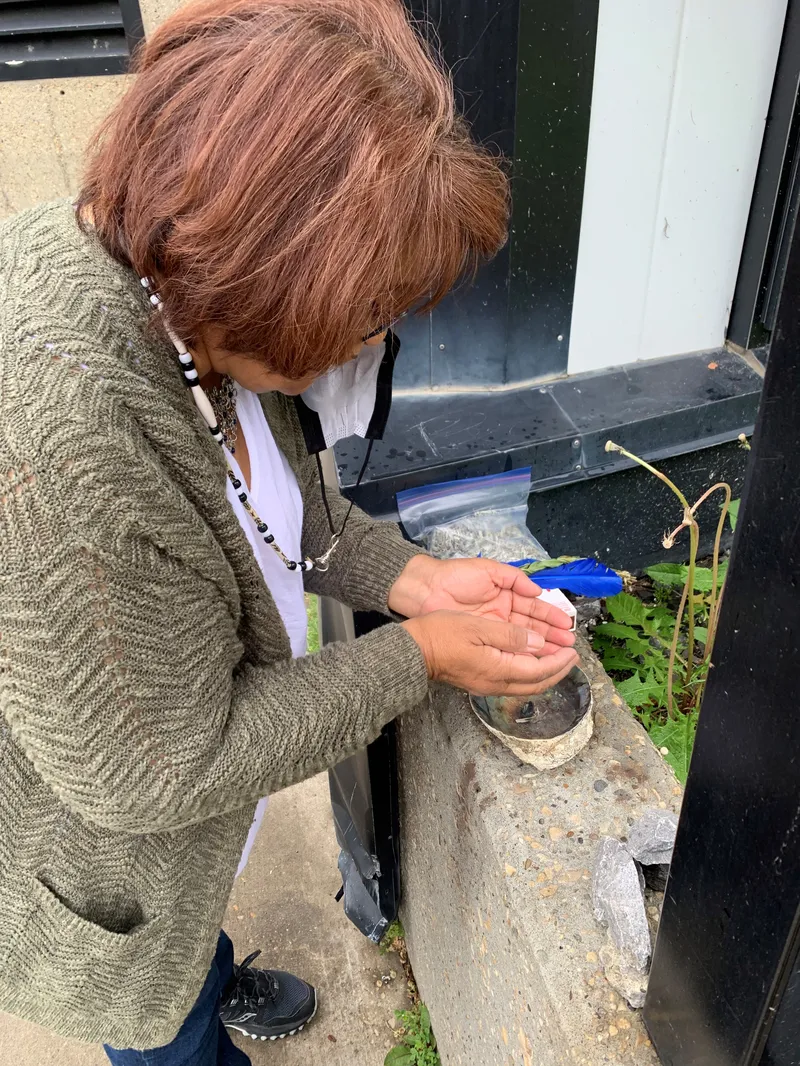
Lynn Lush smudging or cleansing herself.
How to smudge or cleanse yourself: Step-by-step
- Draw the smoke over your head then to your eyes so that you may be able to see the truth around us, the beauty of our mother earth, and the gifts given to us by our Creator.
- Draw the smoke over your ears to cleanse them so they will be open to the request of assistance from others, hear only the good things and allow the bad to bounce off and hear the music of life which surrounds us.
- Draw the smoke to cleanse your mouth so that all we speak will be truthful, speak in a way that will empower positive, caring, and kind words that are full of thanksgiving for our Creator.
- Draw smoke down the front of your body and to the back then to your heart.
- Draw smoke to cleanse your heart so that your heart will feel the love the Creator intended for others so you can grow with harmony and balance. To be good and pure, be opened to show compassion, gentleness and caring for others.
- Draw smoke to cleanse our feet so that our feet will seek to walk gently and respectfully upon Mother Earth, walk closer to our loved ones, friends and community and help us flee our enemies and lead us closer to Creator.
Want to learn more about Indigenous culture? TELUS World of Science – Edmonton has put together a series of videos and activities linking western science with traditional Indigenous ways of knowing. Register for free to watch today.
Definitions:
Four sacred medicines: Cedar, sage, sweetgrass, tobacco.
Cedar: Used for purification and to attract positive energy, feelings, emotions and for balance. Cedar tea has been used as a healing medicine. Cedar crackles when it burns, and the sound is said to wake the spirits. Cedar is also used to restore and protect. For example, its leaves and branches are used to cover the floors and outside walls during sweat lodge or fasting ceremonies.
Sage: Used to cleanse and prepare for a ceremony and often used to purify a home or space. Sage is either rolled into a ball or braided into three strands and can be tied with a red, yellow, black, white or green ribbon. There are different types of sage; women use a particular kind. It is a women's medicine, and offers strength, wisdom, and clarity. It is used to symbolize the life-giving power of women.
Sweetgrass: Used in smudging, along with sage and cedar. The lesson sweetgrass teaches us is kindness. When Sweetgrass is walked upon, it bends, but does not break. So, one of the lessons of sweetgrass is that when someone does us an injustice or hurts us, we are to return it with kindness, as does the sweetgrass, by bending, not breaking when it is walked upon. It is often referred to as the hair of our mother, the Earth. Sweetgrass braids represent, "mind, body and spirit”, “past, present and future”, and “grandparents, myself, grandchildren.”
Tobacco: Offered first in any ceremony. It is said that the plant “activates” all other plants. Indigenous Nations vary in their teachings about tobacco, but for most, it is central to ceremony; it is presented to teachers, Elders, and knowledge keepers if they are helping you. And it is offered before picking medicines or taking other resources from the earth.
Indigenous Science Programming is support by Imperial Oil.
Related Articles

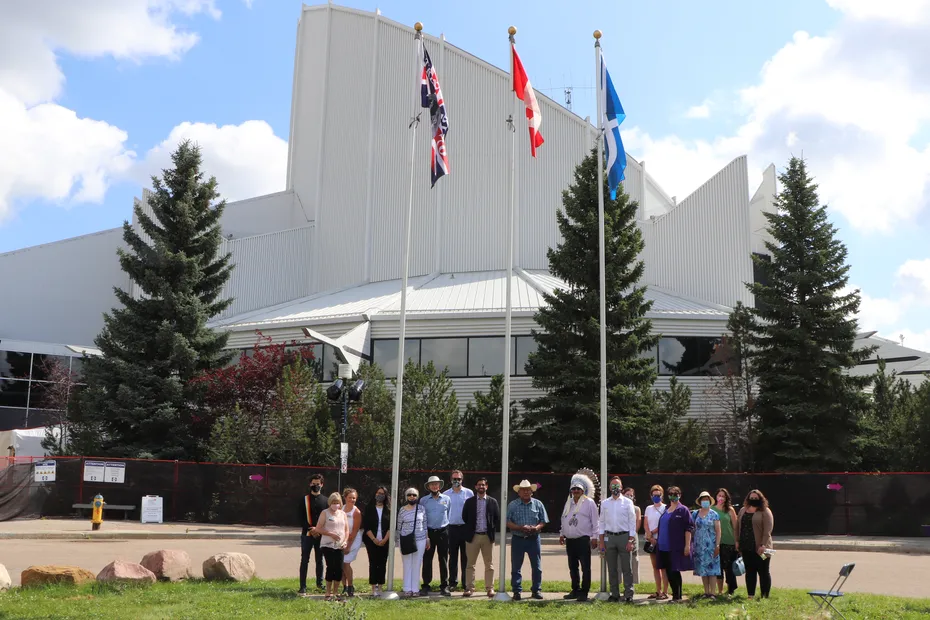
National Indigenous History Month: Introduction to Understanding Protocol
For National Indigenous History Month, we will be sharing a few blogs about Indigenous culture. We encourage you to take the time to learn about Indigenous history and current events.


Guest post - Nahanni National Park Reserve - Kathryn Walpole
In a series of three blog posts, we are delighted to partner with Parks Canada to introduce you to three National Parks and three of the amazing women of STEM who are working together to meet the challenge of protecting these special places for present and future generations.

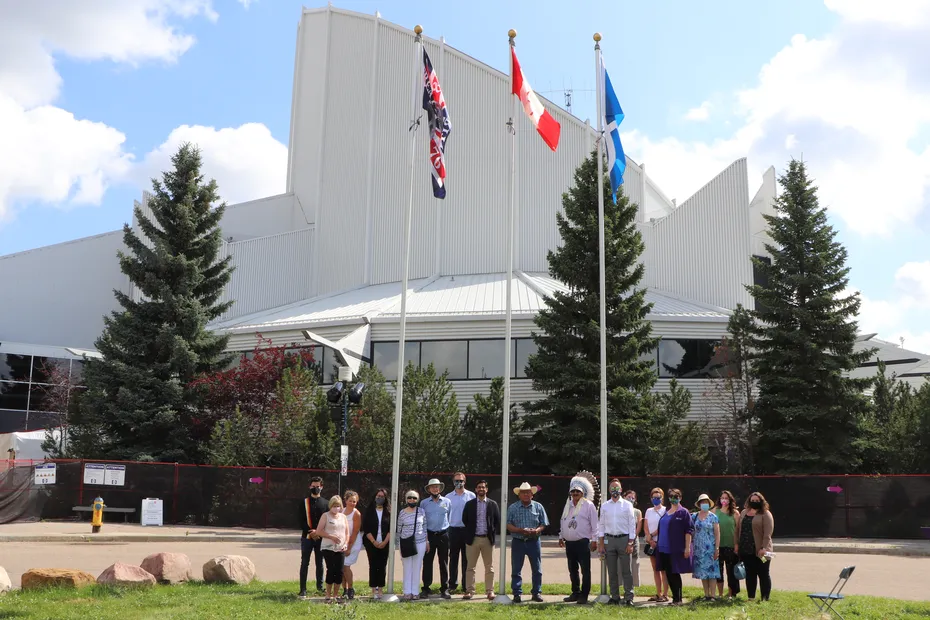
Official Smudge Ceremony
Related Articles


National Indigenous History Month: Introduction to Understanding Protocol
For National Indigenous History Month, we will be sharing a few blogs about Indigenous culture. We encourage you to take the time to learn about Indigenous history and current events.


Guest post - Nahanni National Park Reserve - Kathryn Walpole
In a series of three blog posts, we are delighted to partner with Parks Canada to introduce you to three National Parks and three of the amazing women of STEM who are working together to meet the challenge of protecting these special places for present and future generations.



